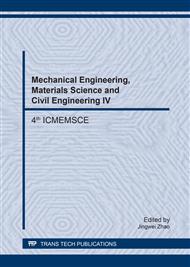[1]
ANSYS Theory Manual, Release 6. 0. ANSYS Inc., USA, 2001: 100-120.
Google Scholar
[2]
E.A. Brandes, G.B. Brook. Smithells Metals Reference Book. London, 1983: 14.
Google Scholar
[3]
Song Jianli. Research on the microstructural characterization and checking control technology of laser cladding forming. A Ph. D dissertation submitted to Shanghai Jiao Tong University. 2006, 09.
Google Scholar
[4]
Zhou Yaohe, Hu zhuangqi, JieWangqi. Solidification technology. China Machine Press, Beijing. 1998: 155-172, 227-236.
Google Scholar
[5]
Yang Sen. Research on laser rapid directional solidification with ultra-high temperature gradient. A Ph. D dissertation submitted to Northwestern Polytechnical University. 2001: 6-10.
Google Scholar
[6]
Tiller W A. Foreword: Quantitative Solidification Science. MaterSci Eng., 1984, 65: 3.
Google Scholar
[7]
Rutter J W, Chalmers B. A prismatic substructure formed during solidification of metals. Can.J. Phys., 1953, 31: 15-39.
DOI: 10.1139/p53-003
Google Scholar
[8]
Tiller W A, Jackson K A, Rutter J W, etc. The redistribution of solute atoms during the solidification of metals. Acta. Metall., 1953, 1: 428-437.
DOI: 10.1016/0001-6160(53)90126-6
Google Scholar
[9]
Mullins W W, Sekerka R F. Morphological Stability of A Partical Growing by Diffusion or Heat Flow, JAppl Phys, 1963, 34: 323.
Google Scholar
[10]
Mullins W W, Sekerka R F. Stability of Planar Interface during Solidification of a Dilute Binary Alloy, JAppl Phys, 1964, 35: 444.
DOI: 10.1063/1.1713333
Google Scholar
[11]
W Kurz, B. Giovanola, R. Trivedi. Theory of microstructural development during rapid solidification. Acta Metall. 1986, 34: 823-830.
DOI: 10.1016/0001-6160(86)90056-8
Google Scholar
[12]
J.S. Langer, H. Müller-Krubhaar. Theory of dendritic growth I: Elements of a stability analysis. Acta Metall. 1978, 26: 1681-1687.
DOI: 10.1016/0001-6160(78)90078-0
Google Scholar
[13]
Hunt J D. Solidification and Casting of Metals. The Metals Society, Book 192. London, 1979, 3.
Google Scholar
[14]
Trivedi R. Interdendriticspacing: PartII. A comparison of theory and xperiment. Metallurgical Transactions, 1984, 15A: 977-9821.
Google Scholar


